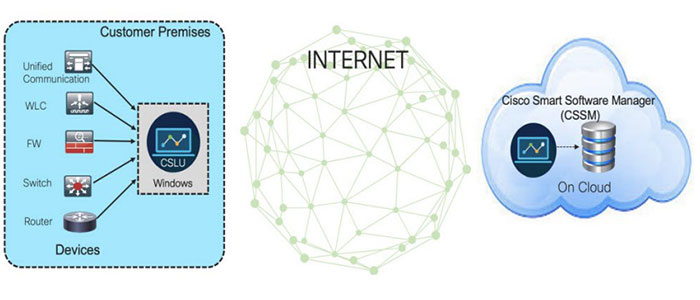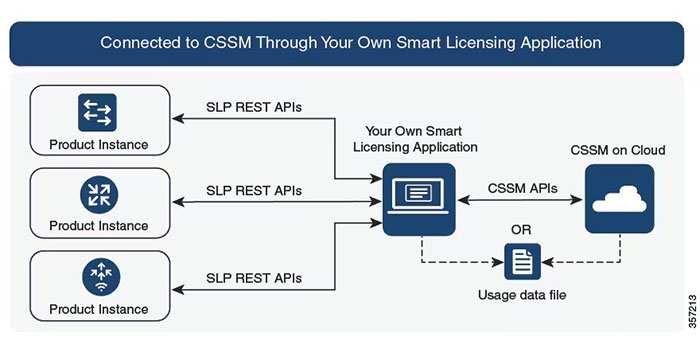Smart Licensing is a Cisco licensing model that provides a streamlined approach to managing software licenses. Unlike traditional licensing models, which require manual management of licenses, Smart Licensing automatically tracks and manages licenses through a centralized portal. This makes it easier for organizations to manage licenses, ensure compliance, and reduce costs.

Smart Licensing works by using a unique identifier called a Smart Account. The Smart Account is a cloud-based account that is used to activate, manage, and monitor licenses for all Cisco products. When a product is purchased, the Smart Account is used to activate the license. The license is then associated with the device and automatically tracked by the Cisco Smart License Utility Manager.
There are several benefits of using Smart Licensing, including:
Cisco Smart License Utility Manager is a web-based tool that provides a centralized portal for managing licenses. The tool is designed to simplify license management by providing a single location for managing licenses, ensuring compliance, and reducing costs.
The Smart License Utility Manager includes several key features, including:
Getting started with the Smart License Utility Manager is easy. To get started, users will need to create a Smart Account. The Smart Account is a cloud-based account that is used to activate, manage, and monitor licenses for all Cisco products.
Once the Smart Account is created, users can log in to the Smart License Utility Manager and activate licenses for their devices. The Smart License Utility Manager will automatically track and manage licenses for all Cisco products associated with the Smart Account.
The Smart License Utility Manager can be used to manage licenses for all Cisco products, including routers, switches, and security appliances. To manage licenses, users can log in to the Smart License Utility Manager and view their device inventory. From there, users can activate, transfer, and manage licenses as needed.
While the Smart License Utility Manager is designed to simplify license management, there may be times when users encounter issues. Some common issues that users may encounter include:
License Activation Issues: Users may encounter issues when activating licenses. This can be caused by a variety of factors, including incorrect license keys or network connectivity issues.
Reporting Issues: Users may encounter issues when generating reports. This can be caused by a variety of factors, including incorrect report settings or data connectivity issues.
License Transfer Issues: Users may encounter issues when transferring licenses between devices. This can be caused by a variety of factors, including incorrect device configurations or licensing restrictions.

SLP stands for Smart Licensing Portal. It is a centralized portal for managing licenses that is part of the Smart Licensing model offered by Cisco. Unlike Smart Licensing (SL), which is a cloud-based licensing model that ties licenses to devices and enables license management through a centralized portal, SLP manages licenses through the Smart Licensing Portal. With SLP, licenses are not tied to devices, but instead are activated and managed through the portal. SLP also provides reporting and analytics on license usage and compliance. SLP is generally recommended for smaller organizations with simpler networks and a need for a more streamlined approach to license management, while SL is recommended for larger organizations with complex networks and a need for increased visibility and control over license usage.
Cisco offers two licensing models: Smart Licensing (SL) and Smart Licensing Portal (SLP). While both licensing models are designed to simplify license management, there are some key differences between the two.
Smart Licensing (SL) is a cloud-based licensing model that enables users to activate, manage, and monitor licenses for all Cisco products through a centralized portal. This makes it easy to track licenses, ensure compliance, and reduce costs. With SL, licenses are tied to devices and can be transferred between devices as needed. SL also provides increased visibility into license usage and compliance.
Smart Licensing Portal (SLP) is a licensing model that uses a centralized portal to manage licenses. Unlike SL, licenses are not tied to devices with SLP. Instead, licenses are activated and managed through the Smart Licensing Portal. SLP also provides reporting and analytics on license usage and compliance.
While both licensing models provide benefits for license management, SL is generally recommended for larger organizations with complex networks and a need for increased visibility and control over license usage. SLP is generally recommended for smaller organizations with simpler networks and a need for a more streamlined approach to license management.
When choosing a licensing model for your organization, it’s important to consider your specific needs and requirements. Some factors to consider when choosing a licensing model include:
To ensure smooth license management with Cisco Smart License Utility Manager, it’s important to follow best practices. Some best practices for managing licenses with Smart License Utility Manager include:
Ensure that records in the Smart License Utility Manager are up to date and accurate. This will help ensure compliance and reduce the risk of errors.
Regularly monitor license usage to identify any issues or potential compliance concerns.
Stay up to date on licensing policies and changes to licensing models to ensure compliance and avoid any potential issues.
Smart Licensing is a relatively new licensing model, and Cisco is continuing to invest in its development. As more organizations adopt Smart Licensing, it’s likely that we’ll see additional features and capabilities added to the Smart License Utility Manager. This will further streamline license management and enable organizations to better track and manage their licenses.

Cisco Smart License Utility Manager is a powerful tool for managing software licenses. By providing a centralized portal for managing licenses, Smart License Utility Manager simplifies license management, ensures compliance, and reduces costs. With Smart Licensing, organizations can automate license management and gain increased visibility into license usage and compliance. By following best practices and choosing the right licensing model for your organization, you can ensure smooth license management with Cisco Smart License Utility Manager.